A VLSI architecture designed to perform real time image compression using SPIHT with arithmetic coder is described here. The main advantage of SPIHT is that it is fully progressive and provide higher PSNR. SPIHT without list is proposed in this paper and which uses breadth first search method. BFS method is suitable for VLSI implementation. In order to archive more performance a high speed arithmetic coder architecture designed with SPIHT. Matlab simulation is used for verifying the result.
Keywords |
| SPIHT, Arithmetic coder, PSNR, Breadth First Search |
INTRODUCTION |
| In recent years, the demand of multimedia products have been growing fast, butconsume large amount of storage space.
Therefore the theory of compression becomes more significant in information theory for reducing transmission
bandwidth and memory. Compression is the process of encoding data using fewer bits. Image compression is one of the
application of data compression. It reduces the amount of data required to represent an image. The objective of image
compression is to reduce the redundancy of image and to store or transmit the image in efficient form. There are 3 types
of redundancy, 1. Coding redundancy 2.Spatial redundancy, 3.Irrelevant information. In an image, neighboring pixels
are correlated and contain redundant information. This type of redundancy is known as special redundancy. Pixel
intensity can be predicted from neighboring pixels. This type of redundancy can be reduced by coding the difference
between the neighboring pixels. |
| In this paper we are implementing an image compression technique in FPGA. The combination of DWT and SPIHT
algorithm is used for image compression. Set Partitioning in Hierarchical Trees(SPIHT) is a wavelet based image
compression method that offers good image quality, fast coding, and high PSNR. It is used for lossless image
compression. For achieving higher performance, a high speedarchitecture of arithmetic coder is designed. |
SPIHT IMAGE COMPRESSION |
| An easy way to comply with the conference paper formatting requirements is to use this document as a template and
simply type your text into it. |
| A. SPIHT(Set Partitioning in Hierarchical Trees) |
| SPIHT is a wavelet based image compression algorithm, proposed by Pearlman and Said in 1996. It offers variety
of good characteristics |
| Good Image Quality |
| • High PSNR |
| • Fast coding and Decoding |
| • Used in lossless image compression |
| • A fully progressive bit stream |
| In SPIHT algorithm, the image first converted to wavelet coefficients . After that, SPIHT divides the wavelet
transform into spatial orientation trees. It is shown in figure 1. Each node represent individual pixels. Every pixel is part
of 2X2 block with its adjacent pixels. There are two types of SPIHT architecture. |
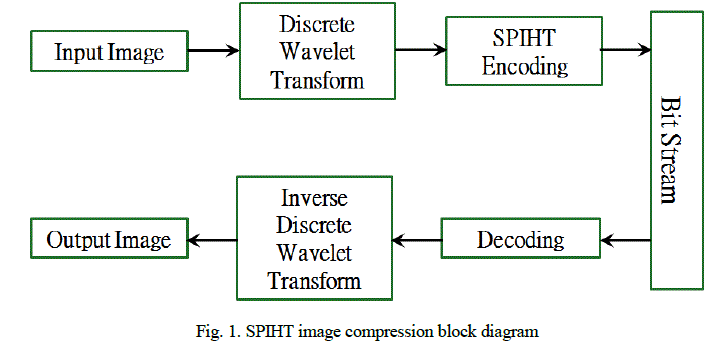 |
| 1) SPIHT with list |
| 2) SPIHT without list |
| SPIHT with list needs dynamic operation and it is difficult for high speed application.SPIHT without list is used in
real time application. This architecture uses fixed order processing through pixel nodes. It offers fast operation. In this
paper we implement the SPIHT without list architecture with breadth first search order. |
| 1) SPIHT with list: It uses 3 different lists to store the significant information about the wavelet coefficients. Three
lists are1. List of insignificant set(LIS) 2. List of insignificant pixels(LIP) 3. List of Significant Pixels(LSP). LIP and
LSP represent individual pixels and LIS represent a group of pixels. Initially LIS contain all the wavelet coefficients
defined by spatial orientation tree. By travelling through each tree node, LIS are portioned and tested for significant
state.The following function is used for testing the significant state. |
 |
| The threshold,τ , for the first bit-plane is equal to 2n, and |
 |
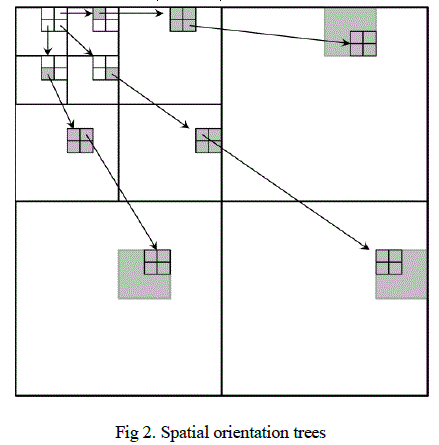 |
| Ci,j is the coefficient value for(i,j) in wavelet domain. If the magnitude of the nodes in the set are less than the
predefined threshold, then the set is insignificant. If it is greater than the threshold then it moves to list of significant pixels.The insignificant sets remain in the LIS; the significant sets are partitioned into subsets, which are processed in
the same manner and at the same resolution until each significant subset has exactly one coefficient. Finally, each pixel
in the LSP is refined with one bit. The above mentioned procedure is then repeated for the subsequent resolution. |
| 2)SPIHT with Breadth First Search : |
| Coding order of a coefficient tree based on SPIHT with list having different order for different image. It is a set
partitioning strategy for making SPIHT efficient. But for hardware implementation we need a fixed path, that is an
approximate order. So we define an order for processing tree coefficient for speedup processing time and reduce
memory size. There are two searching order. One way is Depth First Search(DFS) and other one is Breadth First
Search(BFS) as shown in figure 3. |
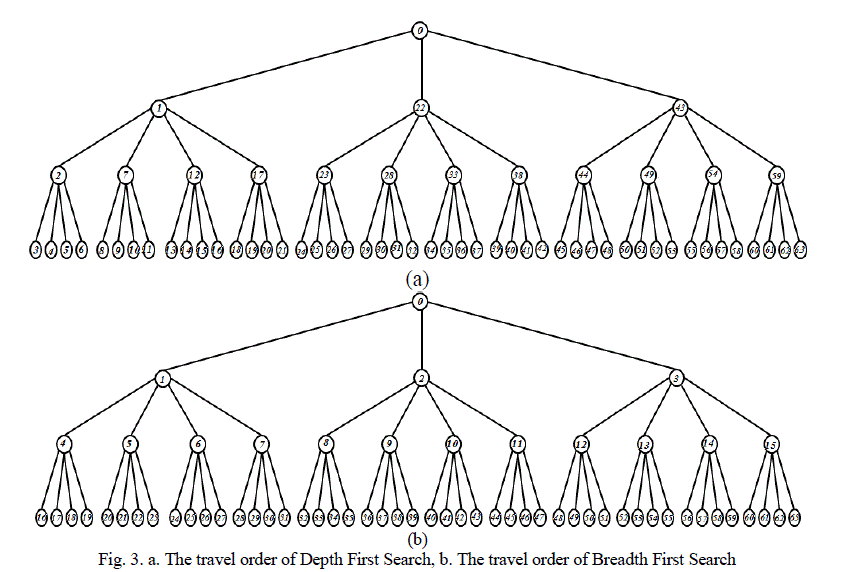 |
| From earlier results SPIHT with BFS is more efficient than SPIHT with DFS. The PSNR(Peak Signal to noise
Ratio) performance of BFS is slightly higher than the DFS.BFS can code more significant information than the DFS.
Also the order of BFS is closer to that of SPIHT with lists. From these characteristics BFS is the good way for
hardware implementation. There are two kinds of symbols involved in coding part. The first kind is significance map
symbols(MAP) for sign bit and position bit of significant coefficients. The other is successive approximation
quantization symbols (SAQ) for magnitude bit of significant coefficients[].The output order of SPIHT is MAP first and
then the SAQsymbols. Pixel’s significant state at the pth bit- plane is defined by the following formula: |
 |
| Sigp(i,j) is the significant state of pixel at(i,j) in pth bit plane, Magp(i,j) is the corresponding magnitude. From this
formula we can obtain the relationship between significance and magnitude of each coefficient. The significant state of
coefficient at pth bit plane is obtained from logic OR operation. |
SYSTEM ARCHITECTURE AND IMPLEMENTATION |
| Figure 4 illustrates the simple architecture of SPIHT with BFS method. The input to the system is raw image pixels
and are provided into transform module first. i.e., Discrete Wavelet Transform(DWT).After that wavelet coefficients are arranged in a tree structure through Tree Generation Module, which reads each node from wavelet memory by the
BFS way. The state information also generated by the same module. |
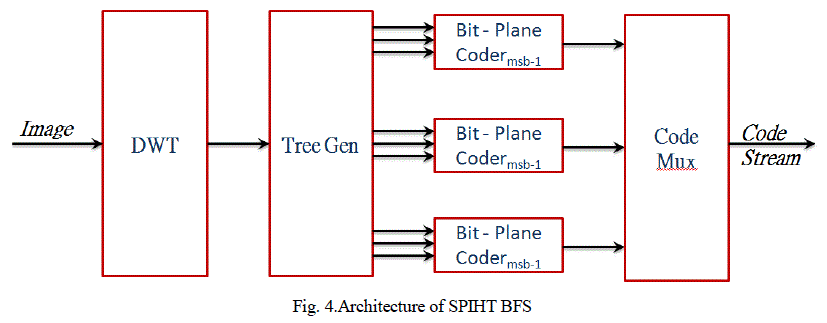 |
| A. Arithmetic Coder |
| Arithmetic coding is a form of entropy encoding. It is used in lossless compression. It differs from other entropy
encoding, such as Huffman encoding. Because in Huffman coding each symbol coded., but in arithmetic coding the
entire message coded into a single number, a fraction of n(0.0 ≤ n ≤ 1.0). |
| Let L be the set of symbols, Every symbol i∈ L, and Probability |
 |
| Codeword for symbol sequence XM = {X1,X2, ............. XM} and there are bits of number. |
 |
| Where p(XM) is the probability of sequence XM and q(XM) is the cumulative frequency of XM. Arithmetic coder is
designed based on three v-size registers: low, high and range. Cumulative count of symbol i is represented by
cum_freq[i],
i.e., |
 |
| The interval for the symbol i is [cum_freq[i-1], cum_freq[i]]. |
| If the current probability interval is [low,high), then the update can be done by the following formula: |
 |
| The precision registers grows with M increments. The normalization procedure explained below. |
| 1) If high< HALF : “0” bit written into output . where HALF= 0.5 X 2v |
| 2) If low ≥ HALF : “1” bit written into output |
| 3) otherwise, output is not defined. In this condition bit_to_follows counter is increased. Then if condition 1 is satisfied
then a “0” followed by bit_to_follows ones written into output. If condition 2 satisfied then a “1” bit and bit_to_follows zeros are written into output. After that to avoid underflowing the registers low and high are scaled. Arithmetic Coder
has shorter length coding. If the input symbol’s probability is high, then shrink of coding interval will be slow. On
other words , if there are some rare symbols then the speed of shrink will be fast. |
| Detailed architecture of SPIHT encoding with arithmetic coder shown in figure. The original image fed to line
based lifting wavelet engine. The wavelet coefficients from line based lifting wavelet engine are written into wavelet
coefficient buffers. The processor dispatcher receives these coefficients from wavelet coefficient buffer in breadth first
search way. These coefficients allocates to one of the arithmetic coders from eight processors array through internal
bus. The parallel architecture provide a wide precision and compression ratio range. The output from arithmetic coder
sent to the corresponding code FIFO by code FIFo dispatcher through the internal bus. The Read FIFO and Truncate
module generate the final code, which read each code FIFO from top to bottom and truncate the code according to the
bit rate requirement. The power management part reduce the power consumption in the system. It will stop the clock
input for unused bit- planes of each arithmetic coder based on maximal bit-plane register file. The configuration and
control part responsible for the settings of parameters like image resolution, wavetype, decomposition and target bit
rate. |
| The Arithmetic coder consist of mainly three parts, Tree Con , bit plane context FIFOs array and the coding core.
The Tree construction part generate spatial orientation tree and it visit the wavelet coefficient by the breadth first search
order. The bit plane context array consists of twelve FIFOs, which store the context values of twelve bit plane. By
using this high speed arithmetic coder we can improve the PSNR about 0.5dB. |
 |
| B. FPGA Implementation |
| FPGAs are an array of logic gates, which can be programmed to perform variety of tasks. FPGA offers a low cost ,
high speed and flexible solution over ASICs. A single FPGA can be used for many tasks, it is fabricated in higher
volume, which reduce fabrication costs. Also we can reprogram, and which allows design modification and bug fixes
without the need to construct a new hardware system. Reprogramming takes only few milliseconds. |
| Spartan 3E FPGA is used in our project. The main advantages are high speed connectivity, high performance DSP
solutions and low cost. The software used for FPGA implementation is Xilinx ISE 10.1. There are softcore microprocessor(MicroBlaze) and hard core embedded microprocessors (PowerPC). MicroBlaze is a virtual
microprocessor that includes the following properties. |
| • Thirty- two 32-bit general purpose registers |
| • 32- bit address line |
| • Single issue pipeline |
| • Separate 32-bit instruction and data bus. |
RESULT |
| SPIHT image compression is simulated in matlab. A 512 x 512 image is considered as the input image. After
applying one level wavelet transformation, the input image is divided into four frequency sub-bands. Wavelet
transformed coefficients are compressed by applying SPIHT algorithm, we got a result PSNR = 56.5583 and MSE =
0.1436.Matlab R2010a is used for simulation. |
 |
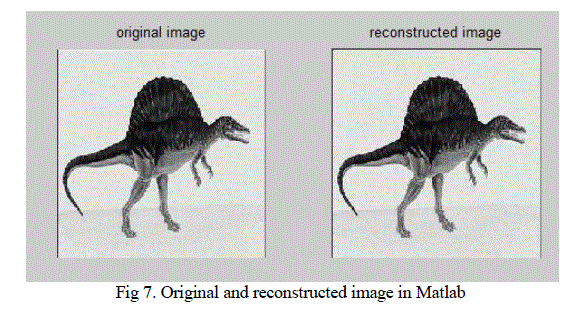 |
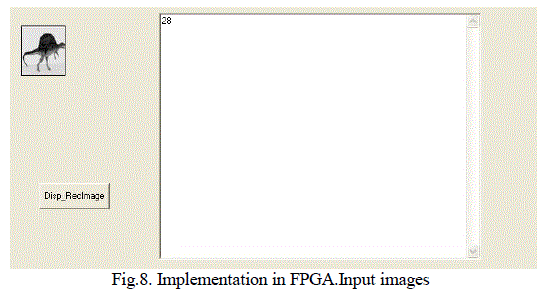 |
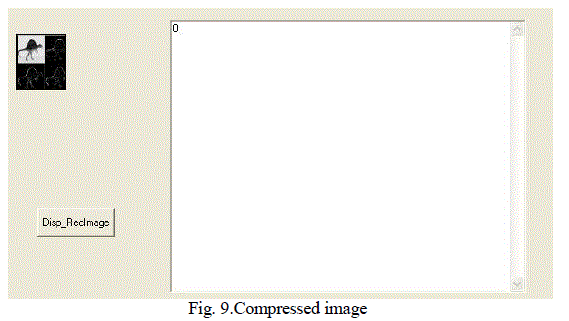 |
| For FPGA implementationa8 bits/pixel and size is 64 x 64 image is used. Results are shown in below figure8 and figure
9.From the device utilization summery, utilization of 4 input LUTs is 77%. This is shown in Table II. |
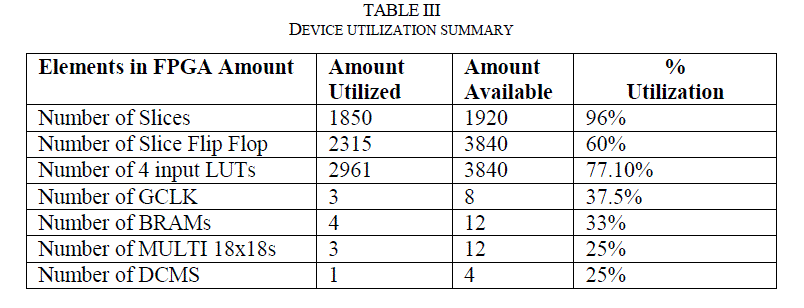 |
CONCLUSION |
| An efficient VLSI implementation of image compression is presented here. SPIHT with arithmetic coder improves the
peak signal to noise ratio. Another highlight of this system is SPIHT without list. The breadth first search is a fixed
order method, which reduce the time requirement. Arithmetic coding makes itself a standard technique for its high
efficiency. SPIHT with arithmetic coding architecture provide a high throughput memory efficient design. |
References |
- Kai Liu, EvgeniyBelyaev, and JieGuo, "VLSI Architecture of Arithmetic Coder Used in SPIHT", IEEE Transactions on Very Large Scale Integration (VLSI) Systems, Volume 20, Issue 4 ,pp. 697-710 April 2012.
- Kai Liu &Jie Lei &YunSongLi,"A Novel VLSI Architecture of SPIHT Using Breadth First Search for Real-Time Applications", Journal of Signal Processing Systems (2012) 68:113-8 125 DOI 10.1007/s11265-011-0581-2
- W.-B. Huang, A. W. Y. Su, and Y.-H.Kuo,"VLSI implementation of a modified efficient SPIHT encoder", IEICE Transaaction Fundamentals, E89-A, volume 12, pp. 3613-3622, December 2006
- A. Said and W. A. Pearlman, "A new ,fast and efficient image codec based on set partitioning in hierarchical trees", IEEE Transaction on Circuits Systems for Video Technology, volume 6, no. 3, pp. 243-249, March 1996
- Y. Wiseman,"A pipeline chip for quasi arithmetic coding", IEICE Transaction Fundamentals, volume E84-A, issue 4, pages 1034-1041, April 2001.
- T. W. Fry and S. A. Hauck,"SPIHT image compression on FPGAs", IEEE Transaction Circuits Systems for Video Technology, volume 15, no. 9, pp. 1138-1147, September2005.
|